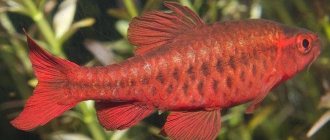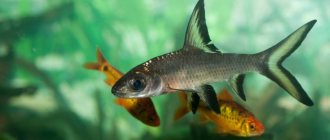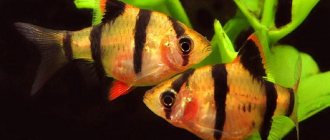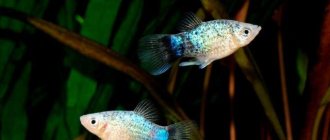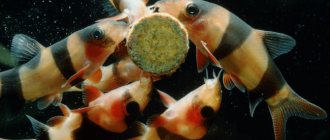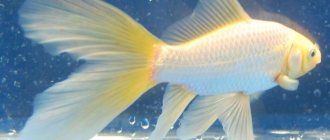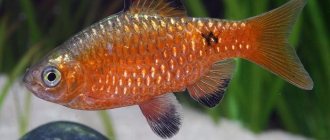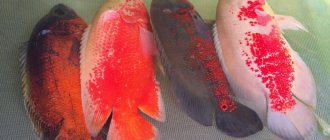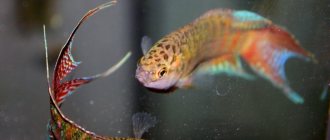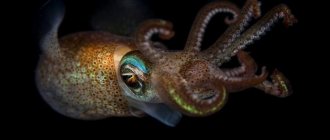Barbs, also known as “Barbels,” also known as “Puntiuses,” deserve special attention from aquarists as the most interesting genus of ray-finned fish for its species diversity, capable of satisfying most of the aesthetic preferences of home aquarium owners.
According to ichthyologists, who prefer to call Barbus “Barbel” Puntius, more than two thousand species of this fish have been recorded in nature. Of these, about forty species, selected by breeders, have successfully established themselves in household aquariums around the world.
Barbus
Puntius received its more familiar aquarium name Barbus, thanks to breeders who, noting the presence of characteristic antennae on these fish, called them Usachi, according to the Russian translation of the English word Barbel - barbel. The name was immediately transformed into the zoological Latin form - Barbus. So, in fact, Barbus is the same Puntius, only adapted to living in an artificial environment.
Opinions about the origin of these fish, which belong to the carp family, are divided. Most experts believe that they appeared millions of years ago in freshwater bodies of modern South and Southeast Asia (primarily India, Pakistan and Southern China). Some believe that it was the reservoirs of Western and Central Africa, formed by the largest rivers of this continent - the Niger and the Congo, that became the refuge of the first Puntius (Barbus).
While it is possible to argue about the origin of the Barbus, the fact that these regions are the main modern natural habitat of their habitat is indisputable.
In Europe, the first classification of Barbs was carried out in the mid-19th century, but they began to appear in European aquariums only in the 30s of the 20th century. In Russia (USSR), Barbs appeared in the late 40s of the last century.
The size range of Barbs is unusually wide - from the smallest Gacilis, 4 cm long, to the largest Shark Barb, reaching 25 cm. Some individuals of Barbs (Puntius) living in the wild can reach 35 cm in length. The average size of most aquarium Barbus species is between 5-12 cm.
The body of the Barbus has an elongated shape, the caudal fin is linear and forked. Most species of aquarium Barbs have a predominant silver-yellow color with dark vertical stripes. Males are characterized by the presence of a bright red edging of the fins; in females this edging is much paler, and may even be absent altogether. All Barbs are particularly active and mobile.
In aquarium conditions, the lifespan of medium-sized Barbs is about 3–7 years, large ones can live up to 10 years.
Table of basic parameters of maintenance, care and nutrition:
| What should be the volume of an aquarium for Barbus? | from 50 liters for 6-8 individuals up to 8 cm in size |
| What should be the temperature in the aquarium for Barbus? | from +15-28 °C |
| What pH should be in the aquarium? | from 6-7.5 pH |
| What should be the hardness of the water in the aquarium? | from 2-18° dH |
| What should be the substrate for an aquarium? | dark, without sharp corners, and for some species sand |
| What kind of lighting should be in the aquarium? | moderate |
| What should be the movement of water in the aquarium? | moderate |
| Maximum fish size | from 5-35 cm depends on the type |
| What does aquarium fish eat? | dry food; live and frozen food: daphnia, tubifex, bloodworms |
| Type of aquarium fish | non-aggressive |
| Who is compatible with in an aquarium? | get along with all non-aggressive fish species |
| Lifespan | up to 7 years in an aquarium |
Habitat
Barbs live in the waters of Africa and Asia; in the aquarium hobby, mainly representatives from Southeast Asia are represented. Wild populations of barbs were brought to some countries and, thanks to their hardiness, took root here without any problems. For example, some species can be found in the USA, Colombia, Australia, and Singapore.
Maintenance and care
Aquarium maintenance of Barbs does not cause much trouble for their owners.
The requirements for water parameters in an aquarium are not particularly strict. The content indicators depend on the type of Barbus, the indicators vary: temperature from +15-28° C, acidity from 6–7.5 pH, hardness from 2-18° dH.
Most species of Barbus feel very good in stagnant water, but you still should not abuse their unpretentiousness, ensuring normal aeration and filtration of water, as well as its traditional regular renewal. It should be especially noted that some species of Barbs, whose ancestors lived in fast-flowing rivers, still require increased water aeration.
Barbs, as a rule, easily adapt to almost any level of aquarium illumination required by its other inhabitants.
Due to the fact that all Barbs are very active and mobile, they require a large elongated aquarium of 30 liters or more.
How many years do they live
How long barbs live in captivity depends on their species and conditions of detention. Small species usually live no more than 3-4 years, medium ones - 6-7 years, and large ones (such as shark baloo) can live up to 10 years. Keeping them at high temperatures, in dirty water with low oxygen levels, as well as regular overfeeding reduces the lifespan of fish. Conversely, when kept in cool water with regular changes, moderate feeding, high-quality filtration and aeration, fish live longer. To prevent the introduction of pathogens into the reservoir, which can lead to the death of fish, all new fish must be quarantined for 2 weeks.
What to feed Barbs in an aquarium
Barbs are omnivores; they, like all ray-finned fish, happily eat live daphnia, cyclops, tubifex and bloodworms. They also like to pick at delicate aquarium plants.
Barbs require a balanced and varied diet. You need both plant foods and live or frozen food. If there is a lack of plant food, Barbs will gnaw at any greenery in the aquarium, which is unlikely to please its owner.
You need to feed in small portions 2 times a day. The food should be eaten within 2-3 minutes. Anything longer than 3 minutes is overfeeding.
In order to improve the health of the aquarium Barbus population, it is sometimes advisable to give them a fasting day, feeding them only plant foods at this time. But such unloading should not be more often than once a week.
Fasting days
It is always preferable to underfeed barbs than to overfeed them.
Due to overfeeding and excess weight:
- The ability to reproduce ceases.
- Premature death occurs.
- Pisces get sick more often.
Fasting days for barbs are carried out once every 7-8 days.
For feeding during the fasting day, granules with spirulina or dry food with an increased level of plant components are used. Give in the morning and evening. Fasting days are contraindicated for fry.
Reproduction, breeding in a community aquarium
Barbus, unlike viviparous fish, lays eggs, from which fry then emerge. To create breeding conditions for Barbs, you will need a separate aquarium, into which fish ready for spawning will need to be transplanted ten days before it begins.
The mating season, as with all small freshwater fish, is accompanied by characteristic mating games - pursuit of females by males and mutual rubbing of their bellies. This behavior of the Barbs, as well as the enlarged abdomen of the females, means that they are ready to spawn. It is very important not to miss the beginning of mating games, since the spawning of Barbs in a common aquarium can endanger their future offspring due to the desire of other fish to feast on fresh caviar. And the Barbs themselves, as a rule, are capable of devouring their offspring.
Typically, fish (males and females) ready for spawning are placed in a fish tank, ensuring the water temperature in it is 2-3 degrees higher than in a general aquarium. Many experts also recommend slightly reducing the water hardness in the spawning area.
During the spawning process, the female Barbus, depending on the species, lays about 500-600 eggs, which are immediately fertilized by the male. Spawning can last up to 2 hours, after which all adult Barbus individuals, in order to prevent them from eating eggs, are returned to the general aquarium.
About a day later, the first fry begin to emerge from the fertilized eggs. After approximately four days, the fry begin to become active in search of food sources. From this time on, they should begin to be fed with the so-called “live dust”, containing the smallest ciliates, rotifers, as well as cyclops and daphnia crustaceans.
How to distinguish a female from a male Barbus
Different species of Barbs may have their own specific characteristics of gender, but there are also general, almost unmistakable, external differences between males and females:
- the female is always larger than the male, her abdomen is more convex;
- the color of the female is always paler than that of the male;
- The color of the edges of the male's caudal fin, starting from the 4th month of life, increases significantly.
Lifestyle, character of fish
Barb fish are nimble, agile, playful, so they need free space to swim. They are constantly busy with something, all the time exploring the ground in search of something edible. They usually live in the middle and lower layers of water. Due to the increased activity of bright beauties, the aquarium must be covered with a lid, as they can easily jump out of the water and die. Even during feeding, you need to be careful so that the fish does not “escape” to the land that is destructive for it.
Barbs have a Weberian apparatus, which provides them with exceptional hearing. They do not like bright light, it simply scares them, so there should be floating algae on the surface of the water, which will provide the darkness necessary for this type of waterfowl.
Compatibility with other fish in the aquarium
The need for a large aquarium for Barbs is associated not only with their increased mobility, but also with the need to provide additional space to prevent dramatic conflicts not only with their neighbors in the aquarium, but also with each other.
For example, such slow fish as Guppies, Cockerels, Angelfish and others like them, in a cramped aquarium, can be fairly plucked by Barbs.
You certainly shouldn’t house Barbs with large predatory fish, for example, Astronotus, which can only be resisted by large species.
It is recommended to keep Barbs with Platies, Parrots, Mollies, and Swordtails, which are very similar in disposition and lifestyle.
Applies to all Barbs! It is not recommended to house Barbs with fish that have long fins - these fins will be plucked by Barbs. Barbs also need to be kept in a flock of 6 or more individuals, otherwise they will conflict with each other.
Vitamins
With the help of vitamin solutions and drops, they strengthen the health of barbs, improve their general condition and coloration. Fish need:
| Name | Effect |
| D 3 | Important for bone growth |
| A | Stimulates reproduction |
| E | Activates the synthesis of reproductive hormones |
| TO | Needed for hematopoiesis |
| IN 1 | Essential for the nervous system |
| AT 2 | Improves the condition of the skin and mucous membranes |
Aquarists recommend using multi-preparations from the Sera series. 5-6 drops. added to water or portions of food.
Types of Barbs
As noted above, out of more than two thousand species of Barbus, only 30-40 species have adapted to aquarium life. Many names of Barbus species in various sources are significantly distorted, and are completely absent from the zoological classification. This creates confusion, which requires the participation of highly specialized specialists to resolve.
Currently, 15-20 species of Barbus are more or less well and reliably described, of which six species can be distinguished, the most popular among Russian aquarists:
Shark Barb
Shark Barb in zoological reference books - Shark Bala, has disappeared in the natural environment.
It received its name for the similarity of its fins to shark fins in shape and color shades. It has mirror-silver scales. It lives in a flock of 5 individuals, but can also live in pairs of 1 female and 1 male. The length of the Shark Barb reaches up to 35 cm. It is possible to distinguish a male from a female only after reaching a length of 15 cm.
Aquarium size from 300 liters. The aquarium must have a lid, as the fish are active and can jump out of the aquarium. Vegetation is also desirable in the aquarium, but with room for maneuver. Water temperature from +24-26° C, acidity from 6.5-7.5 pH, hardness from 4-12° dH. Life expectancy is up to 10 years.
Cross Barbus
Cross Barbus or Puntius-Lateristriga. It has an elongated body, up to 15 cm long. The back of the fish is olive in color with red hues, the sides are golden brown. Aquarium size for a flock of 8-12 individuals from 150 liters. The temperature in the aquarium is from +18-26° C, acidity is from 6-7 pH, hardness is up to 10° dH.
When in danger, the Cross Barbus burrows into the ground, so the soil in the aquarium should not be traumatic - it is coarse or fine sand, small pebbles or gravel without sharp corners.
You can feed the Cross Barbus with dry, live, or frozen food. The best feeding is a balanced diet.
To distinguish a female from a male, you should look carefully at the color. The male is brighter in color and looks slimmer. For reproduction, you need 1 male and 2 females, which need to be placed in a separate spawning aquarium with a size of 50 liters or more. This aquarium should have a temperature of up to +28° C, there should be plants and a separator net should be placed on the bottom. The flow from aeration should be weak. Over the course of a couple of weeks, the stocked fish need to be fed generously. The female lays up to 500 eggs.
The pattern in the form of a cross on the body of Barbus the Cross becomes almost invisible with age.
Barbus Sumatran
Sumatran Barbus The color of the fish is dominated by yellow tones, and there are four vertical dark stripes on the body. The length of an adult is up to 6 cm. Sumatran Barbs are also found with a predominance of green tones, up to 9 cm in length.
The Sumatran Barbus can jump out of the aquarium, so the aquarium must have a lid. The size of an aquarium for a flock of 5 or more individuals will be comfortable from 50 liters. The soil in the aquarium is unimportant. The water temperature in the aquarium is from +21-26° C, acidity is from 6.5-7.5 pH, hardness is from 5-18° dH. The lifespan of the Sumatran Barb is 4-6 years.
If there are less than 3 individuals in the aquarium, then Sumatran Barbs will show aggression among themselves and towards other inhabitants of the aquarium.
For food, it prefers live or frozen food, but can also be fed with dry food.
Schubert Barbus
Schubert's barb reaches a length of up to 7 cm. The body of the fish is flattened on the sides. The main color is from lemon to yellow-red, the fins are from pinkish to bright red.
Schubert's barb is a peaceful aquarium fish that can be kept with any peaceful fish. But it is desirable that the size of other fish be the same 7 cm or a couple of cm smaller or larger.
The size of the aquarium for a flock of 8 individuals is from 50 liters. Aquarium temperature from +18-24° C, acidity from 6-8 pH, hardness from 2-15° dH. Lifespan up to 7 years.
You can feed live, frozen, dry food.
Barbus Five-Striped
Barbus Five-Stripes has the main color tones - copper-red, and there are five vertical dark stripes on the body. The length of an adult is up to 5 cm.
The Five-Stripe Barbus must be kept in a flock of 5 individuals and in an aquarium of 50 liters or more. The water temperature in the aquarium is from +23-26° C, acidity is from 6-7 pH, hardness is up to 10° dH.
Barbus Five-Stripes is a peaceful fish that is compatible with all fish of similar size and character.
You can feed live, frozen, dry food.
Fire Barbus
The Fire Barb has a characteristic feature - the absence of antennae. The length of an adult is up to 8 cm, and in the wild it reaches up to 15 cm.
It lives in a flock of 6 individuals, requiring an aquarium of 50 liters or more. Temperature from +18-26° C, acidity from 6.5-7.5 pH, hardness from 8-15° dH. Life expectancy is up to 5 years.
You need to feed them varied and balanced: live, frozen and dry food.
Interesting Facts
Many subspecies of Barbus are often capable of mutual crossing and the birth of new offspring with interesting color morphs.
Barbs still amaze ichthyologists and aquarists with their variety of colors, shapes, sizes, behavioral styles and intelligence.
From illness, from stress, and with age, the bright color can turn pale and completely discolored.
Russian aquarists first began keeping these pets only in 1946.
A single Barbus behaves timidly in an artificial reservoir, hides in algae, but, as a rule, dies very quickly. A flock of several individuals plays happily and plays pranks.
Some varieties of Barbus are real aquarium long-livers and live more than 10 years, for example, Shark Baloo.
BARBUS SOLAR
BARBUS PINKID
BARBUS OLIGOLEPIS OR ISLAND BABBLE
BARBUS COZUATIS
YELLOWFIN PEARL BARBUS
BARBUS LONG-STRIPED
FIVE STRIPED BARBUS
BARBUS OLIVE
BARBIES OF SRI LANKA
AFRICAN BARBS
LARGE BARBES
SCHUBERT'S BARBUS
BARBUS DENISONI
LADY BARBUS
BARBUS GOLDEN BARBUS MOSSY, BARBUS TIKTO, BARBUS MUTANT
BARBUS FOUR LINE
BARBUS BLACK
BARBUS OLIGOLEPIS
BARBUS LATERISTRIGA
SHARK BALA
SUMATRAN BARBUS
BARBUS SCARLET
BARBUS ARULIUS
BARBUS BUTTERFLY
BARBUS CHERRY
BARBUS TWO-POINT
BARBUS GREEN
BARBUS CLOWN
Diseases, symptoms, treatment
Barbs have strong natural immunity to most viral and infectious fish diseases. The main cause of Barbus diseases, as a rule, is gross violations of the rules for their maintenance and care.
Ovarian cyst in a female Barbus
A sign of the onset of the disease is excessive enlargement of the female’s abdomen, which is uncharacteristic of pregnancy in the fish.
An ovarian cyst in female Barbs can occur due to constant feeding of them with one (albeit combined) dry concentrated food, as well as as a result of long-term separation of males and females. Due to the chronic course of this disease, it is usually detected too late, when the fish have already become infertile or die.
Therefore, there are no methods for treating this disease, as such, and to prevent it, it is important to use preventive measures - proper varied feeding of Barbs and ensuring harmonious communication between females and males.
Ichthyophthiriasis in Barbs
The cause of the disease is an equiciliated ciliate.
It is the most dangerous ectoparasitic disease, very often leading to the death of not only the entire aquarium population of Barbs, but also other fish in a given aquarium.
A sign of the onset of the disease are small white grains on the body of the fish.
Ichthyophthyriosis should be treated by an experienced ichthyopathologist. Medicines used are “Malachite green”, “Violet “K” and potassium permanganate.
Gill rot (Branchiomycosis)
Gill rot is the most severe disease of Barbs. The reason is a fungal infection, the source of which, most often, is live daphnia and cyclops, capable of forming a specific fungus under conditions of elevated water temperature in the aquarium from +27-32° C.
Fungi infect the gill vascular system of fish, causing it to rot. A sick fish does not eat and is usually located near the surface of the aquarium water.
Positive results from the treatment of this disease are possible only at the very beginning of its manifestation. Griseofulvin and Rivanol are used, diluted in the water of a quarantine aquarium, according to the instructions.
Reviews
My husband became interested in aquarium fish. At first, I liked the water tank simply as a good air humidifier, but when my husband put a flock of colorful striped barbs in it, my attitude changed. Our whole family enjoys watching the behavior of these aquarium fish. This is just some kind of relaxation after a hard day. In addition, they turned out to be absolutely not difficult to care for. Irina, 42
At the bird market, I was attracted by the bright red color of a genetically modified Sumatran barb, so I immediately bought it and added it to the female guppies in the aquarium. At first everything was fine, but then a colleague at work shared two beautiful male guppies for my females. On the very first evening, the handsome men lost their tails, and by the morning, their lives. Since then, female guppies and one fighting barb have lived with me. So be careful!Nik86
Features of behavior
Barbs are widely known as very active aquarium fish. This is not only their advantage, but also their disadvantage, because sometimes their activity turns out to be excessive. They are very playful and fast, so they literally do not tolerate slow individuals in the aquarium. But there are small individuals that are quite peaceful, so they can easily get along with many aquarium inhabitants.
Barbs are schooling fish, so you should not buy them in quantities of 1 or 2 individuals. As a rule, 6-10 individuals are enough for their normal life in an aquarium. If you introduce one barb into an aquarium, it will experience a lot of stress due to loneliness, which can lead to aggression towards other aquarium fish.
Barbs are constantly on the move, looking for something and catching up with each other. For this reason, they are suitable for those who prefer active fish. They will decorate both general and species aquariums.
Bottom line
The breeds of barbs are so diverse that an aquarist can always choose the ideal option for himself. Aquarium fish are a wonderful hobby that is interesting at any age. Barbs remain one of the most common inhabitants of home ponds due to the variety of forms and because of their undemanding conditions. Barbecue aquariums, which combine several breeds of these fish, look no worse at home than exotic sea ones.
The difference between a male and a female
Heterogeneous barb individuals differ in appearance from each other. these distinguishing features vary for each species. Let us note some of them using the example of the Sumatran barb.
Firstly, the female is always larger than the male and has a voluminous abdomen.
Secondly, the male is always brighter and more contrasting.
Thirdly, after 3 months of life, the edges of the male’s caudal fin become reddish.
Equipment
Barbs love water saturated with oxygen, so you should immediately take care of purchasing the following equipment:
- Filter. Can be external and internal. When choosing, first of all, you should focus on the power of the device. It would be desirable to have additional functions, such as adjusting the flow speed.
- Compressor. Creates the necessary aeration of water, which is important not only for the barbs themselves, but also for the vegetation in the aquarium.
- Thermostat, with which the required temperature is regulated and maintained.
The design of the aquarium can be chosen in the same style as the natural habitat of these fish: South and Southeast Asia, Africa, etc. You can place driftwood, stones, and more living vegetation inside.
When planting plants, you need to think about their location in advance. Barbs are very active, so there is no need to plant everything with vegetation - give them a free area where they can frolic. It is advisable to place large plants in the back space.
Ground and lighting
Coarse quartz sand and sea pebbles can be used as soil. It is advisable to choose a soil of a darker color - this way the barbs will look more impressive.
These fish are unpretentious to the level of lighting, so there are no special requirements here. You can choose the type of lighting that is preferable for the vegetation that you plant in the aquarium.
Mating games
It is required to select two manufacturers. If the queen begins to attack too much and attack the male, it is better to replace him, otherwise you may be left without offspring at all.
There must be algae in the tank, as it provides protection to the parents. When the fish calm down, they are quickly transplanted into a common aquarium. The completion of spawning is also indicated by the behavior of the female, as she begins to avoid contact with the male.
Approximately 12 hours after the completion of spawning, eggs without an embryo can be identified - they become white and cloudy. It can be easily removed using a pipette.
Caviar yield
After spawning is completed and the breeders return to the general aquarium, you need to reduce the amount of water in the tank to 10 cm. The mesh is removed after 12 hours and carefully removed from the eggs.
Next you need to add methylene blue to the water. This prevents contamination of the eggs and helps to find unfertilized specimens.
After about a day, the larvae begin to appear. At first, they feed on the reserves of the gall sac. After 12 hours, change half of the water to boiled or distilled. Three days later the fry appear.
To prevent mutation of eggs and to avoid colors unusual for barbs, you need to shade the aquarium.
